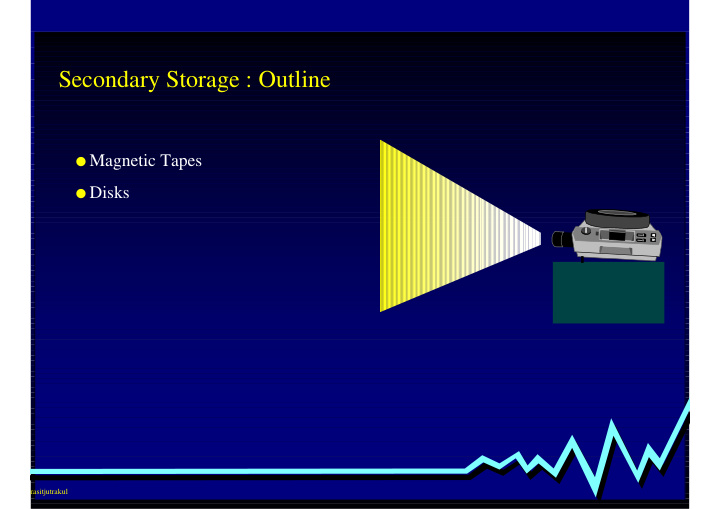



Secondary Storage : Outline ! Magnetic Tapes ! Disks rasitjutrakul
Magnetic Tape " Sequential access " Compact " Easy to store and transport " Less expensive " Storing data off-line " Archival storage rasitjutrakul
Organization of Data on Tapes " Data are stored sequentially on a set of parallel tracks. Track Frame 1 0 1 1 1 0 1 1 0 Gap Gap Data block rasitjutrakul
Density and Capacity " Density (bytes per inch, bpi) – the number of characters that can be recorded in an inch of tape. ( e.g. 800, 1600, 6250, 30000 bpi ) " Capacity – the number of bytes that can be stored in the entire tape. " Capacity = Length x Density – (2400 x 12) x (1600 bpi) = 44 Mbytes rasitjutrakul
Utilization BlockSize = Utilization + BlockSize GapSize 100 80 60 Utilization (% ) 40 20 0 400 800 1200 1600 2000 2400 2800 3200 Block size (bytes) rasitjutrakul
Data Transfer Rate " Typical transfer rate : 10 ft / sec " However, the maximal data transfer rate (MDTR) is never attained. " Effective data transfer rate (EDTR) – r : time to read user's data – ss: time to start and stop the tape – gt: time spent in the interblock gap r = ⋅ EDTR MDTR + + r ss gt rasitjutrakul
Effective Data Transfer Rate " BlockSize = r� MDTR, GapSize = gt� MDTR r =++⋅ EDTR MD rss gt rasitjutrakul
Effective Data Transfer Rate r = ⋅ EDTR MDTR + + r ss gt 150000 100000 EDTR 50000 0 400 800 1200 1600 2000 2400 2800 3200 Block size (bytes) rasitjutrakul
Fixed-Length Records HEADER IBG BLOCK IBG . . . BLOCK IBG TRAILER RECORD RECORD . . . RECORD EDTR r = + + ⋅ r ss gtMDT rasitjutrakul
Variable-Length Records HEADER IBG BLOCK IBG BLOCK IBG IBG TRAILER BDW RDW REC. 1 BDW RDW REC. 1 RDW REC. 2 BDW SDW1 REC. 1 SDW2 REC. 2 IBG BDW SDW2 REC. 2 . . . Variable-length unspanned unblocked record format Variable-length unspanned blocked record format Variable-length spanned blocked record format rasitjutrakul
Magnetic Disks Spindle 3 2 1 0 Actuator Cylinder Direct Access Storage Device (DASD) Direct Access Storage Device (DASD) rasitjutrakul
Organizing Tracks " Sector-addressing " Block-addressing rasitjutrakul
Organizing Tracks by Sector 1 1 8 6 7 3 2 4 3 7 6 8 5 5 4 2 Interleaving factor Interleaving factor rasitjutrakul
Organizing Tracks by Sector sector 3 2 4 1 3 4 2 5 1 Sector-addressing scheme Sector-addressing scheme rasitjutrakul
Organizing Tracks by Block sector 3 4 2 5 1 block 3 4 2 5 1 Block-addressing scheme Block-addressing scheme rasitjutrakul
Organizing Tracks by Block Count subblock Data subblock Count subblock Data subblock Count subblock Key subblock Data subblock Count subblock Key subblock Data subblock block block IBG rasitjutrakul
Organizing Tracks by Block " Plus : – Physical space allocation of records corresponds to logical organization. – No internal fragmentation. – No need to load two blocks to access one record. " Minus : – More nondata overhead. – Extra work for programmer and file system. – Large block may cause track fragmentation. rasitjutrakul
Clusters & Extents " Cluster : – a collection of contiguous blocks (or sectors) " Extent : – a collection of contiguous clusters. " A file : a series of – blocks – clusters – extents Minimize seek time Minimize seek time rasitjutrakul
Disk Capacity " NC : Number of cylinders per disk pack " TPC : Number of tracks per cylinder " TC : Capacity of each track " DC : Disk capacity = ⋅ ⋅ DC NC TPC TC bytes IBM3350 : 555 cylinders, 39 tracks/cyl, 19254 bytes/track disk capacity = 397 MBytes ( * including system data ) rasitjutrakul
Disk Access " Seek time – average seek time ≈ 1/3 of the max. seek time " Head-switching time – negligible ≈ 0 " Rotational delay – half a revolution (3600 rpm ≈ 8.3 msec) " Data transfer time – # data transferred, rotation time rasitjutrakul
Comparisons of Disk Drives Speed/Capacty 3.5-inch IBM 3380 floppy Avg seek time (ms) 70 17 Rotational delay (ms) 50 8.3 Transfer rate (MB/s) 0.2 3.0 bytes/track 9,200 47,476 track/cylinder 2 15 cylinder/drive 80 1,770 MB/drive 1.4 2,520 rasitjutrakul
Disk as Bottleneck " Disk performance is increasing. " But disk speeds still lag far behind CPU and local network speeds. " Techniques : – Disk striping - splitting a file on several drives – Disk cache – RAM disk rasitjutrakul
Device Storage Allocation " Keep track of what blocks are in use and what blocks are free. – Bit map used ... free – Free chain block block block block block block block block rasitjutrakul
Recommend
More recommend